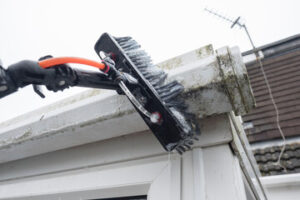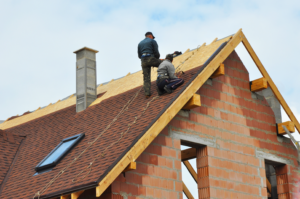Gutter Cleaning involves the removal of leaves, twigs and other debris from your gutters. It also includes flushing the downspouts and inspection for any clogs or damage.
Hiring a professional gutter cleaner means that you can rest assured the job will be done correctly. Gutter Cleaning is a lot safer and more effective when it is done before the leaves fall. Visit https://www.stlouisguttercleaningservices.com/ to learn more.

Gutters are designed to funnel rainwater away from a building, thereby protecting it from damage. However, if they become clogged with debris, they can’t do their job properly. This can cause water to overflow and seep into the walls and foundation of a home, leading to costly repairs. Regular gutter cleaning helps prevent this from happening and ensures that your home is well-protected.
Gutter cleaning is one of the most important maintenance tasks that can be done at home. It’s also one of the most un-fun chores, especially since it requires climbing up on a ladder and using a hose to flush out any debris. This task should be done at least twice a year, preferably in the spring and fall. If you’re willing to put in the work and are comfortable working on a ladder, then cleaning your own gutters isn’t too difficult. However, it’s important to always use ladder safety techniques like keeping your body between the side rails and working on level ground.
If you’re not up for cleaning your own gutters, it’s a good idea to hire a professional service. Not only will they be able to clean your gutters more thoroughly, but they’ll also be able to inspect them for signs of damage and make any necessary repairs.
Clogged gutters aren’t just an eyesore – they can also be a breeding ground for mosquitoes, rodents, and other pests. These pests thrive in standing water, which is commonly found in clogged gutters. If left unchecked, these pests can then spread to other parts of the house, causing further problems. Regular gutter cleaning removes these breeding grounds and keeps pest infestations at bay, minimizing the need for expensive pest control services.
Over time, clogged gutters can lead to damaged fascia boards and rotting soffits. In addition, if water is allowed to permeate through the walls of a home, it can cause mold and mildew, which can affect the health of family members and pets.
Preventing Water Damage
Gutters are meant to channel rainwater away from the structure of your home and its foundation. When they become clogged, however, water can start to pool around the foundations of your home and cause settlement cracks. Over time, this can compromise the stability of your house and lead to expensive repairs. Regular cleaning of your gutters can prevent this from happening.
Another problem with clogged gutters is that they can overflow and start to leak into your roof. This is especially a concern when it rains or snows. The leaks can cause damage to your roof, shingles, and insulation and can promote the growth of mildew and mold inside your home. Gutter cleaning prevents these problems by ensuring that your gutters are clear of debris and properly draining water.
If you’re planning to clean your own gutters, be sure to have the right tools. A ladder with a secure footing, a bucket, and a gutter scoop or garden trowel are essential items. If you don’t have a ladder, consider hiring a professional to do the job for you. They’ll use specialized tools to ensure that your gutters are thoroughly cleaned, and they’ll also inspect them for signs of sagging or damage.
Professional gutter cleaners will also use a gutter vacuum to clear out the remaining debris and dirt. They can even install gutter covers to prevent debris from entering the gutters in the first place. This will reduce the frequency of cleaning, and keep your gutters looking great for longer.
Overhanging trees and bushes can drop leaves, sticks, and branches all year long, but regular gutter cleaning can help you avoid these problems. In addition to cleaning your gutters, it’s also important to have trees and shrubs trimmed regularly to prevent them from overhanging your home. This will keep debris from getting trapped in your gutters, and it will also protect your roof from damage caused by falling branches and limbs.
Preventing Clogged Downspouts
The best way to prevent downspout clogs is to perform regular cleanings. This can be as simple as getting on a ladder and pulling out any large debris that you can see. This is usually easier on a sunny day when the leaves and debris have had a chance to dry out.
Another good way to prevent clogs is by adding gutter downspout filters. These can be bought from most home improvement stores and are a simple way to catch larger debris before it can reach the downspouts. However, homeowners must remember that these are not a permanent solution and the debris will still get into downspouts if it doesn’t make it through the filter.
If your downspouts are constantly clogged, there may be an issue with the gutter system or its installation. If you suspect this is the case, it is important to call a professional who can use specialized equipment to clean the downspouts without risking any falls or injuries.
A professional can also be helpful if you have downspouts that are hard to access. This is especially true if your downspouts extend underground or have a lot of turns that are difficult to navigate with a ladder. A professional can use a powerful plumbing auger to break up a stubborn clog and clear out the downspout. They can also repair any issues that are preventing the downspout from draining properly. This can save you a lot of time and money in the long run.
Preventing Pests
If your gutters are clogged, it’s only a matter of time before pests like rodents and birds find their way inside. They are attracted to the warm, moist environment in clogged gutters where they can build nests and hide from predators. These pests can then cause even more damage when they start chewing and digging away at the structure of your home.
Keeping your gutters clean prevents this from happening by allowing water to flow freely and keep your home safe. Regular cleaning also helps reduce the need for costly repairs and maintains the overall value of your property.
To avoid clogs, make sure your gutters are free of leaves, twigs, and debris. Check the downspouts for blockages, as well. If you can’t remove these obstructions yourself, a professional service can help. You can also avoid clogged gutters by trimming back your trees, which can reduce the amount of debris that falls into your gutters in the first place.
When gutters aren’t cleaned, water can overflow and pool around the foundation of your house. This can damage your exterior walls and the wood structure of your roof. It can also erode the soil around your foundation, leading to cracks and other structural problems. Clogged gutters can also lead to mold growth, which not only damages your home’s structure but can also be harmful to your family’s health.
Gutters are designed to channel water away from the foundation of your house, preventing damage to the walls and foundation. However, they can become clogged with leaves and twigs, making them an ideal habitat for pests. Regular professional gutter cleaning prevents this from happening, preventing pest infestation and keeping your home protected.
There are a number of ways to prevent pests from entering your gutters, including installing gutter guards and using natural repellents. These natural solutions are easy to apply and don’t use harsh chemicals that can harm your family or the environment. They also provide a cost-effective way to keep pests at bay. You can also purchase traps that are designed to capture pests without harming them. These are great for those who want to keep their home pest-free without sacrificing the safety of their pets and children.
